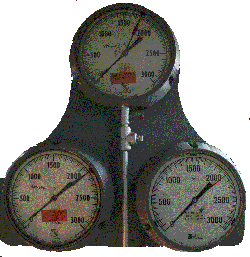 |
Below Decks The guts of the ship, is where the traditional duties, and running of the vessel occur. Here is where the engines move the ship, and provide power. It is also where the steering gear, and mechanics of the weaponry are housed. The enlisted men are berthed down here, with the gear that they run and service. These are not the glamorous parts of the ship; but without them, the Turner Joy is rendered useless. Watertight doors are in place to seal everything off, in case of battle damage, and prevent sinking. The entire ship is very well compartmentalized. |
 |
|
|
|
|
|
Above: This is one of the large bunk areas, for enlisted men. Though not nearly as claustrophobic as those in a submarine, it is still pretty tight. Left: Bunks are stacked three high. each bunk has a storage area, under the mattress. This is the naval equivalent of the solder's footlocker. |
|
|
Bunks are crammed in wherever room can be found, often squeezed in between machinery spaces. |
|
|
A closer look at a display of what a typical sailor might keep on board. Though it does not seem like much, the ship is, in many ways, like an ant colony. Everything, food, laundry, entertainment, medicine, is provided. |
|
|
This is the yeoman's office. This is essentially the business office of the ship. All records are kept here, as well as all requests for transfers, leave, training. All promotions come through this office. |
|
|
An emergency generator. Should the engines ever be knocked out, emergency power can keep the electronics up, and the guns firing, as well as the ventilators circulating air, and the pumps going. |
|
|
Some parts of the distributing and storage systems for the emergency power system. |
| An emergency generator, from above. | |
|
|
A look aft, from the head of the emergency generator room, towards the steering room. |
|
|
|
|
This is the steering room. looking aft. The man with me is Earl, who works at the museum. Earl has worked on this ship before, and is quite familiar with it. He had served in the Navy during three wars, starting with WWII, and ending with Viet Nam. Generally, the ships dual rudders are controlled by the helmsman on the bridge; but in war, you have to be ready for anything. There are two steering stations here, one for each rudder. If the bridge should be destroyed, or the lines cut, the ship can be steered from this station, via orders given through the radio, or by messenger. Left: If things get really bad, and the hydraulics are shot out, the brass crank handle shown here, can be attached directly to the gearing system of each rudder, which can then be turned by hand. Below: Earl stands at the steering station. Each rudder has its own wheel, and its own position indicator. A set of speakers sits directly behind the steering station, to blare commands. There is also a phone, and an intercom. The gauges between the steering stations, indicate the state of the steering hydraulics. |
|
|
|
|
|
|
One of the ships machine shops. At sea, a warship needs to be capable of extended operation, and a certain amount of independence. Nearly anything that might break, can be repaired, or remade in these shops. |
|
|
|
|
|
Above: Earl guides me through the complicated maze of the machinery spaces. For most of us, and engine is an engine, a single piece of machinery in which fuel goes in one end, and exhaust goes out the other. During the process, energy is increased, which we use to do work. This is not the case on a Naval ship. In a ship, the engine is divided into three sections, the boilers, the turbines, and the reduction gear. The place is fantastically complicated, like crawling around inside of an old mechanical watch. Left: Earl stands in front of one of the boilers, pointing out the speaking tube. Below: A boiler, with the engineering panel in the foreground. |
|
|
|
|
|
|
|
|
Above: The engineering panel Left: The main steam stop valve (try saying that three times fast). This is where the steam from the boilers is controlled. It is essentially an on/off switch. Below: Some of the many other valves and controls around the boiler, which make this place incomprehensible to an outsider. |
|
|
|
|
|
A port opens onto the boiler, to give us a look inside. |
|
|
Inside of the boiler, the museum installed a light, to give a better look. |
|
|
|
|
|
Above: The turbines, and reduction gear, where they join up. power will now go down the shaft to the propellers. Left: A view of the reduction gear, with the gearing visible through the watch glass. |
|
|
|
|
|
We head up the ladder, and leave the lower deck areas - for now. We will be coming back down latter, to look over the forward portion of the machinery spaces. |